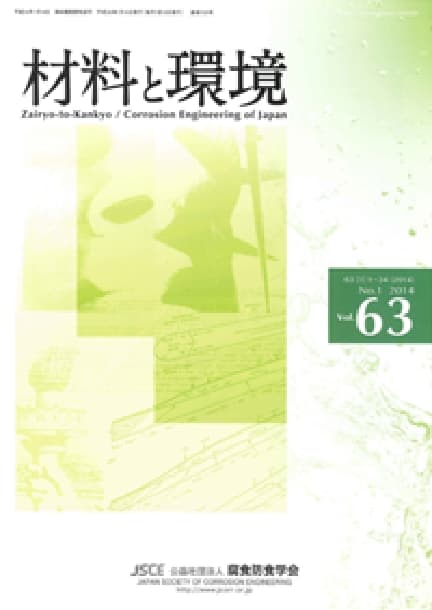- TOP
- Zairyo-to-Kankyo
- Vol. 61 (2012), No. 6
Zairyo-to-Kankyo Vol. 61 (2012), No. 6
Backnumber
-
Vol. 74 (2025)
-
Vol. 73 (2024)
-
Vol. 72 (2023)
-
Vol. 71 (2022)
-
Vol. 70 (2021)
-
Vol. 69 (2020)
-
Vol. 68 (2019)
-
Vol. 67 (2018)
-
Vol. 66 (2017)
-
Vol. 65 (2016)
-
Vol. 64 (2015)
-
Vol. 63 (2014)
-
Vol. 62 (2013)
-
Vol. 61 (2012)
-
Vol. 60 (2011)
-
Vol. 59 (2010)
-
Vol. 58 (2009)
-
Vol. 57 (2008)
-
Vol. 56 (2007)
-
Vol. 55 (2006)
-
Vol. 54 (2005)
-
Vol. 53 (2004)
-
Vol. 52 (2003)
-
Vol. 51 (2002)
-
Vol. 50 (2001)
-
Vol. 49 (2000)
-
Vol. 48 (1999)
-
Vol. 47 (1998)
-
Vol. 46 (1997)
-
Vol. 45 (1996)
-
Vol. 44 (1995)
-
Vol. 43 (1994)
-
Vol. 42 (1993)
-
Vol. 41 (1992)
-
Vol. 40 (1991)
Keyword Ranking
13 Dec. (Last 30 Days)
Zairyo-to-Kankyo Vol. 61 (2012), No. 6
Hydrogen Absorption Behavior of Steel Bar for Prestressed Concrete in a Solution of Ammonium Thiocyanate
Tomoki Doshida, Kenichi Takai, Mikiyuki Ichiba
pp. 249-256
DOI:
10.3323/jcorr.61.249Abstract
A solution of ammonium thiocyanate is used in the FIP (Fédération International de la Précontrainte) test as a hydrogen charging method. Though this method is comparatively simple, fracture time in the FIP test and hydrogen content often differ among various testing institutes. However, the detailed hydrogen absorption behavior in the solution is still not clear. In this context, the effects of existing states of hydrogen, oxide film on the specimen surface, specific solution volume to specimen surface area, immersion time and solution temperature on the hydrogen absorption behavior of a steel bar for reinforcing prestressed concrete were investigated by immersing it in the solution. The amount of absorbed hydrogen increased with immersion time, reached its maximum, and then decreased with increasing immersion time. A main factor of the decrease in the amount of absorbed hydrogen was corrosion products, including Fe, O and S, formed on the specimen surface, since the amount of absorbed hydrogen increased again as a result of merely polishing the surface. This indicates that corrosion products formed on immersing specimens in a solution of ammonium thiocyanate strongly affect hydrogen absorption behavior. Whereas, variation of the solution, such as increase in pH, during immersion also affects slightly hydrogen absorption behavior.
Readers Who Read This Article Also Read
Tetsu-to-Hagané Vol.98(2012), No.5
Article Access Ranking
13 Dec. (Last 30 Days)
-
Delayed Fracture Mechanism of 1700 MPa-Class Quenched and Tempered Bolt under Atmospheric Corrosion Environment
Tetsu-to-Hagané Advance Publication
-
Perspectives on the Promising Pathways to Zero Carbon Emissions in the Steel Industry toward 2050
ISIJ International Vol.65(2025), No.2
-
Effect of B on Surface Oxidation Behavior and Phosphatability of Si-Mn-added Cold-Rolled Steel Sheets
ISIJ International Advance Publication
-
Factors Influencing the Bonding Phase Structure of Iron Ore Sinters
ISIJ International Vol.43(2003), No.9
-
Effect of microstructural heterogeneity on fatigue limit of as-quenched low-carbon low-alloy martensitic steel
ISIJ International Advance Publication
-
Prussian blue as a fully reversible hydrogenochromic material for visualizing hydrogen distribution in Fe sheet
ISIJ International Advance Publication
-
Progress of Strip Casting Technology for Steel; Historical Developments
ISIJ International Vol.52(2012), No.12
-
Research Progress on Optimal Blending of Iron Ore Powders for Sintering
ISIJ International Vol.65(2025), No.12
-
-
Microstructures and Reduction Properties of High CaO Concentration Sintered Ore
ISIJ International Advance Publication
You can use this feature after you logged into the site.
Please click the button below.










